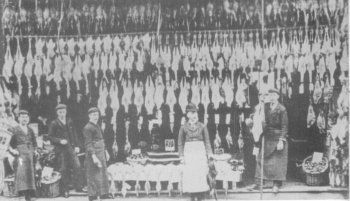Jewry Street
Introduction

The photograph of No. 45 Jewry Street in 1905, was taken five years after the first Medical Officer of Health was appointed in Winchester. Since then the Food and Drugs Acts of 1955 and the Regulations of 1966-70 control both hygiene and dress.
The price of beef steak in the 1890s, at under one shilling a pound, with bread at two pence a loaf, should be linked with earnings.
At that time the rent of a house (in Sussex Street) was 6s. 4d. weekly when the average wage was £1. 10s.
In 1983 the rent of a small council house was £12 and the average weekly wage £100.
Foreword
This Roman town, known as Venta Belgarum had a typical rectangular street pattern within the walls, the High Street being the main east west thoroughfare.
Godson's map of 1750 shows it as Jail Street; earlier it was known as Jury Street and at all times it was a direct route to Southampton and the continent.
Historical
All the old buildings in Jewry Street, except the Congregational Church, the Elizabethan Restaurant and the De Lunn buildings, were influenced by the introduction of renaissance architecture from Italy.
Inigo Jones, the architect for the church in Covent Garden, the Banqueting Hall in Whitehall and the Queen's House, Greenwich, visited Italy in the 17th century. He saw there the revival of Roman classical architecture already well established since the 15th century. Its introduction into England broke the continuity of traditional detail in house building. Tudor-Elizabethan features were gradually replaced, projecting mouldings were used at roof and wall junctions, and to emphasise door and window openings.
The use of Roman type columns, on the Corn Exchange and Nos. 30-31, and 35-37, are clearly derivative. Vertical strip divisions, known as pilasters, with classic mouldings top and bottom, can be seen at Nos. 22-25.
The Georgian period (1702-1830) produced its own version of classic architecture as seen at No. 29.
Following these changes came two revival periods. The pointed arch Gothic, seen in churches since the 12th century, was re-introduced in the 19th century. Two buildings show these changes. The 1853 Congregational Church by W F Paulton is in Early English Gothic (1189-1307) the other 19th century revival was Greek architecture, a modest example being the Old Market House in Market Street (1857).
Jews in Winchester
The history of the Jews in Winchester, their persecution and perseverance, is probably typical of the integration also seen in other towns. They were here for centuries in and around Jewry Street, with a school and numerous private and public synagogues, (also to be seen in St Peter Street and St George's Street). They came from Normandy and were well established by the 12th century. Their skills in finance led them to be hated by the barons who borrowed money. Records indicate some Jews were executed in the 12th and 13th centuries for "having martyred christian children to provide blood for paschal rites".
All Jews were to be expelled at the end of the 13th century but, as in Germany and Holland, evidence remains, in the following centuries which points to their continuing financial skill in both banking and the retail business.
Listed Buildings
Under the Town and Country Planning Act 1971 the Secretary of State for the Environment has a duty to compile lists of buildings of special architectural or historic interest. Buildings are classified in grades according to their relative importance:
Grade I Buildings of Outstanding Interest.
Grade II Buildings of Special Interest.
of which particularly important ones are graded II*.
Consent is required for the demolition of a listed building and for its alteration or extension, and this is distinct from normal planning permission.
All applications must be advertised in a local newspaper, a notice displayed near the site, and amenity groups such as the Victorian Society and the Winchester Preservation Trust, along with at least six similar bodies are given due notice. The Historic Buildings and Ancient Monuments Act 1953 awards grants for the repair of individual buildings.
